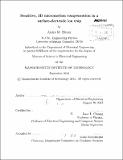| dc.contributor.advisor | Isaac L. Chuang. | en_US |
| dc.contributor.author | Eltony, Amira M. (Amira Madeleine) | en_US |
| dc.contributor.other | Massachusetts Institute of Technology. Department of Electrical Engineering and Computer Science. | en_US |
| dc.date.accessioned | 2014-02-10T16:56:50Z | |
| dc.date.available | 2014-02-10T16:56:50Z | |
| dc.date.issued | 2013 | en_US |
| dc.identifier.uri | http://hdl.handle.net/1721.1/84871 | |
| dc.description | Thesis (S.M.)--Massachusetts Institute of Technology, Dept. of Electrical Engineering and Computer Science, 2013. | en_US |
| dc.description | Cataloged from PDF version of thesis. | en_US |
| dc.description | Includes bibliographical references (pages [47]-53). | en_US |
| dc.description.abstract | Following successful demonstrations of quantum algorithms and error correction with a handful of trapped ions in a macroscopic, machined Paul trap, there is a growing effort to move towards microfabricated traps with all the electrodes on a single chip. These traps, known as surface-electrode ion traps, are more amenable to being shrunk in size and replicated, or integrated with optical components and electronic devices. However, in the shift towards surface-electrode traps, and as traps are miniaturized in general, laser beams are brought closer to electrode surfaces, exacerbating laser-induced charging. Because of their charge, trapped ions are extremely sensitive to stray charges that accumulate on the trap surface. The DC potentials caused by stray charge displace the ion from the null of the RF trapping field, resulting in a fast, driven motion of the ion (known as micromotion) which hinders quantum operations by broadening transitions and causing decoherence. In a surface trap, micromotion detection is difficult as the laser beams used for measurement typically cannot crash into the trap, obscuring ion offsets out of the trap plane. Existing methods for micromotion detection permit ion positioning accurate to the ground state wavepacket size (of order 10 nm), but cannot identify ion offsets out of the trap plane with the same accuracy. Schemes for sensitive compensation often have restrictive requirements such as access to a narrow atomic transition. We introduce a new approach, which permits out-of-plane micromotion compensation to within 10s of nanometers with minimal overhead. Our technique synchronously detects ion excitation along the trap axes when it is driven by secular-frequency sidebands added to the RF electrodes; the excitation amplitude is proportional to the offset from the RF null. We make a detailed theoretical comparison with other techniques for micromotion compensation and demonstrate our technique experimentally. | en_US |
| dc.description.statementofresponsibility | by Amira M. Eltony. | en_US |
| dc.format.extent | 53 pages | en_US |
| dc.language.iso | eng | en_US |
| dc.publisher | Massachusetts Institute of Technology | en_US |
| dc.rights | M.I.T. theses are protected by
copyright. They may be viewed from this source for any purpose, but
reproduction or distribution in any format is prohibited without written
permission. See provided URL for inquiries about permission. | en_US |
| dc.rights.uri | http://dspace.mit.edu/handle/1721.1/7582 | en_US |
| dc.subject | Electrical Engineering and Computer Science. | en_US |
| dc.title | Sensitive, 3D micromotion compensation in a surface-electrode ion trap | en_US |
| dc.title.alternative | Sensitive, three-dimensional micromotion compensation in a surface-electrode ion trap | en_US |
| dc.type | Thesis | en_US |
| dc.description.degree | S.M. | en_US |
| dc.contributor.department | Massachusetts Institute of Technology. Department of Electrical Engineering and Computer Science | |
| dc.identifier.oclc | 868331212 | en_US |
